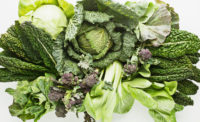Chemicals from Tires and Roads Detected in Leafy Greens

Image credit: Robert Laursoo via Unsplash
A recent study conducted by researchers with the University of Vienna and the Hebrew University of Jerusalem has found tire-derived compounds in leafy greens samples, indicating that chemicals in tires are taken up by crops.
Particles from tires and road wear are significant contributors to the abundance of microplastics entering the environment. In fact, estimates of tire and road wear particle emissions range widely, from 0.9 to 2.5 kilograms (kg) per capita per year, which corresponds to between 24 percent and 94 percent of total microplastics emissions. Moreover, tire and road wear particles have been estimated to contain 5–10 percent organic and inorganic additives by weight, for many of which toxicity has been established. Despite its prevalence, tire and road wear particle pollution is still poorly understood.
In light of the mounting evidence demonstrating biological effects of tire-derived compounds, as well as their recent detection in human urine, the researchers sought to investigate the concentration of tire-derived compounds in commercial produce and the exposure via dietary intake. The researchers focused on leafy greens crops because leaves have been shown to accumulate more organic contaminants than other plant organs.
For the study, the scientists collected and analyzed two sets of leafy vegetable samples, including spinach, lettuce, and kale. The samples were collected from retailers in Switzerland between February and April 2023, and from commercial fields in Israel in 2017. The samples purchased in Switzerland were grown domestically, and were also imported from Italy and Spain. Samples were shipped frozen to Austria for analysis; samples from both sample sets were extracted between March and May 2023.
The researchers detected six tire-derived compounds, with at least one compound present in 71 percent of samples. Based on the presence of the tire-derived compounds in the samples and local dietary habits, the researchers estimated a total daily intake of the chemicals of 0.04–1.296 nanograms (ng) per person per day, depending on individual leafy green consumption.
Statistical analyses did not reveal correlation between known growth conditions and tire-derived compound concentrations in the leafy vegetable samples, and the estimated daily intake of these compounds via leafy vegetable consumption was generally lower than or comparable to the estimated daily intake through other known sources. Still, the study demonstrates that tire-derived compounds are taken up by foods, and the researchers speculate that exposure to these compounds might be higher for other produce. The findings point to the need for future research into exposure of the transformation products of tire-derived compounds, and the biological effects associated with this exposure.
Looking for a reprint of this article?
From high-res PDFs to custom plaques, order your copy today!






